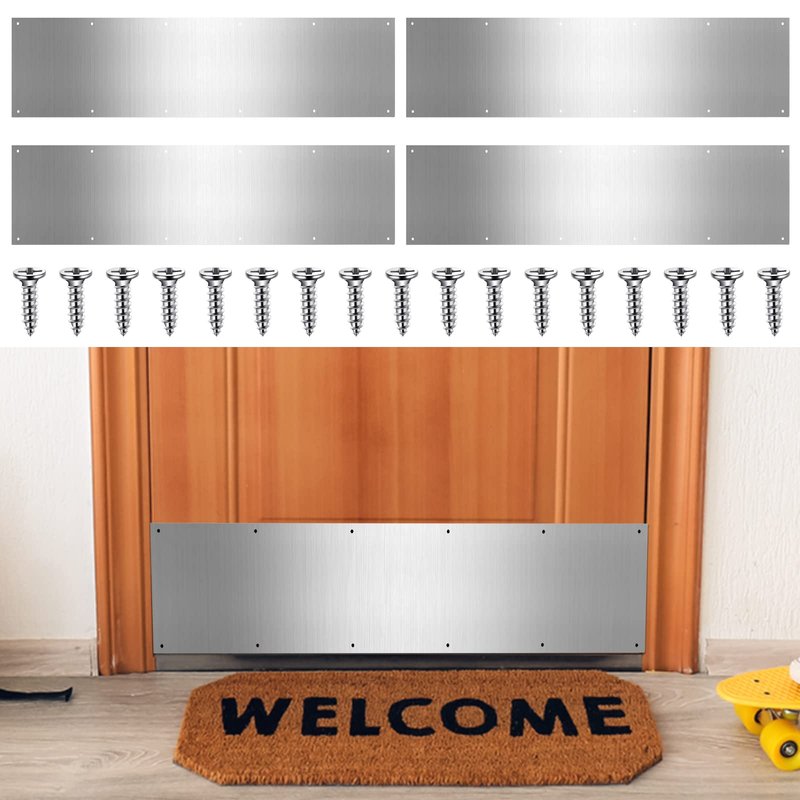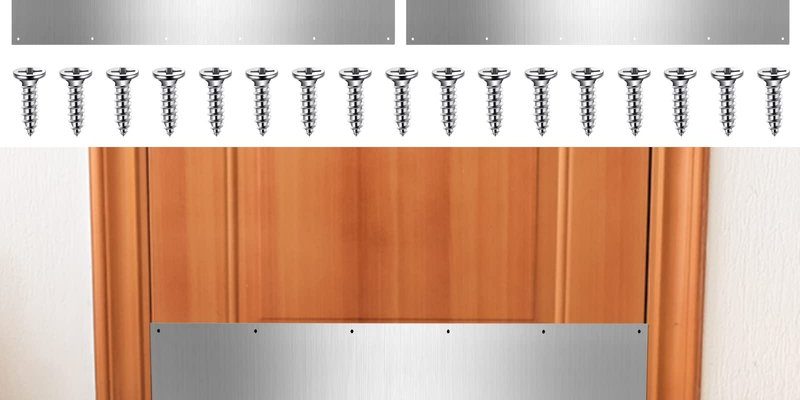
The thing about a kick plate is, it’s supposed to shield your door from the daily abuse of shoes, pets, or rolling luggage—kind of like a screen protector for your phone. But if it’s not installed just right or the door flexes more than you’d expect, that thin piece of metal can start to rub, scrape, or even dig into the paint or wood every time you open or close the door. If you’ve just noticed the scratching, or it’s gotten worse over time, don’t worry. Let’s break down why this happens and how you can fix it without turning your door into a DIY nightmare.
Why Is My Kick Plate Scratching the Door?
When a kick plate leaves marks on your door, it often means something is out of sync. Usually, the kick plate isn’t flush against the surface, or it’s moving around more than it should. Sometimes, thin doors (especially hollow-core or lightweight wood) flex as they open and close, causing the metal plate to scrape across the paint or wood. Other times, it’s an issue with the screws—they might be loose, too tight, or the wrong length entirely.
Another thing to consider: not all kick plates are cut evenly on the back, which can cause sharp edges to dig into softer door materials. If you’ve noticed scratches that match the shape or corners of your plate, this is a dead giveaway. Some homeowners see visible lines where the plate ends or even faint impressions across the full width of the door. These signs point straight to the kick plate as the main suspect.
Honestly, you might even see this issue more with certain brands or cheaper aftermarket kick plates. The metal edges may not be fully deburred, or the design might not allow for enough clearance. And if your door bangs open or swings shut hard, tiny movements add up—like a slow-motion sanding machine rubbing the door raw over time.
How to Inspect the Kick Plate for Problem Areas
Let me explain how you can track down the trouble spots. Start with a close look at both the kick plate and the door itself—use good light and maybe even take off the plate if it feels loose. You’re looking for:
- Scratches, scuffs, or chipped paint right at the top or corners of the kick plate
- Tiny gaps between the plate and the door, especially if you can slip a piece of paper into them
- Metal burrs or sharp corners on the plate’s back side
- Loose, missing, or too-long screws sticking through the other side
If you gently wiggle the kick plate and it moves, that’s a clear sign it’s not fully secured. Sometimes, you’ll even see a dusting of metal or wood shavings right below the scratches. Keep an eye out for warping, too—if your door flexes, the plate may bow away, causing even more friction. A thorough inspection makes it much easier to figure out what’s out of alignment before you start fixing things.
Common Causes: Installation Mistakes and Hardware Choices
Most often, scratches happen because of something simple during installation. Maybe the kick plate was placed just a bit too high, so as the door swings, it rubs against the jamb or weatherstripping. Or, the screws were overtightened, which bows the plate and causes sharp spots to press into the door surface. Using the wrong screw length is another classic issue—if they poke through, you get surprise gouges on the other side.
You might be wondering if the type of kick plate or the base door material makes a difference. It does. Heavier plates (like solid brass or steel from brands such as Baldwin or Defiant) are less likely to warp, but can leave deeper scratches if misaligned. Lightweight aluminum plates are easier to bend, which can cause uneven contact. If you’ve reused old screws, or just grabbed whatever was handy, that could throw the whole “sync” of the hardware out the window, causing minor but repeated impacts with every door open.
If you did a DIY install with paired adhesives instead of screws, double-check for any spots where the glue or tape has failed. Even a slightly peeling edge can turn into a scraping hazard.
Step-by-Step Fix: How to Stop a Kick Plate from Scratching
Here’s the thing: you don’t need carpenter-level skills to solve this, just some patience and a bit of troubleshooting. Let’s walk through a basic fix:
- Remove the Kick Plate: Unscrew or unclip it gently. Keep your hardware organized—you’ll want to reset everything later.
- Check Edges and Finish: Run your finger along all sides. If you feel any burrs or sharpness, smooth them with a metal file or fine sandpaper. Pay extra attention to corners where most scratches start.
- Inspect Door Surface: Clean off dust, old paint chips, or adhesive residue. If there are deep scratches, now’s a good moment to touch up with paint or wood filler.
- Reinstall Thoughtfully: Make sure the plate lines up with the bottom of the door and sits totally flush. Don’t overtighten the screws—just snug enough so the plate can’t move. If needed, use foam tape or thin rubber washers to cushion between plate and door.
If you’re still seeing movement or hear a scraping noise, don’t be afraid to check again. Sometimes even an extra washer or a new screw makes all the difference.
Choosing the Right Kick Plate and Hardware
If you’re considering swapping out your old plate, here’s where you can make your next install basically scratch-proof. Look for a kick plate that’s slightly smaller than the full width of your door—this leaves a buffer so it can’t scrape against the jamb. High-quality plates from trusted brands like Schlage or Baldwin usually have smoother edges and a better finish.
Pay attention to the included hardware. Short, flat-head screws are safest—they’ll hold the plate tight without poking through. Universal kits are available, but make sure everything’s in sync with your specific door thickness and material. And if you’re working with a metal door, self-tapping screws can make the process easier without splitting anything.
It’s tempting to save a few bucks with a generic or DIY aluminum plate, but honestly, spending a bit extra on a well-made, brand-specific kick plate saves way more hassle in the long run.
Preventing Future Scratches: Long-Term Solutions
No one wants to deal with this issue more than once. To keep things smooth, always check the tightness of your hardware every few months—especially if you notice the door closing harder in winter (temperature swings can make things shift). You might even consider clear adhesive bumpers (the kind used for cabinet doors) between the plate and door for a little extra cushion.
If your door flexes a lot—maybe it’s older, hollow-core, or a bit water-damaged—it might be worth reinforcing the bottom panel with a bit of wood glue or extra hardware before reattaching the kick plate. For rental properties, look into screwless or snap-on plates that can be reset or swapped without leaving permanent marks. And whenever you repaint or refinish your entry, take the plate off first. That prevents paint buildup at the edge, which can increase friction when you reinstall.
If you treat your kick plate like a removable phone case—something to be checked, cleaned, and reset every so often—it’ll keep your door protected (not damaged) for years.
When to Call in a Pro or Try Alternatives
Sometimes, even a careful DIY fix doesn’t solve the problem. If your door is old, warped, or just doesn’t line up right with the frame anymore, it might be time to get a pro’s opinion. A misaligned door can make even the best kick plate impossible to sync up properly. Local locksmiths or door specialists can adjust hinges, fill in old gouges, or recommend custom-fit plates.
As an alternative, you could try vinyl or plastic kick plates. These are softer and less likely to scratch, though they won’t be as tough as metal in the long run. For pet owners, consider clear guards or adhesive sheets designed for scratching—these protect without adding any new edges to the mix.
Either way, the right troubleshooting will keep your door’s finish looking fresh and save you from repainting every few months.
Wrapping Up: Keeping Your Door and Kick Plate in Sync
A kick plate is meant to be a bodyguard for your door, not its worst enemy. Most scratches and scuffs come down to tiny installation issues—wrong screws, sharp edges, or loose hardware. With a careful inspection, the right tools, and a few simple tweaks, you can stop the damage in its tracks.
Remember, it’s all about finding the right fit—matching your kick plate, screws, and door material so everything moves smoothly together, without friction. By treating your kick plate as something to be checked and maintained, not just installed and forgotten, you’ll keep your front door looking sharp (and scratch-free) for years to come. If you ever feel stuck, don’t hesitate to ask for help or try switching to a different style of plate. Sometimes, the best troubleshooting is just trying something new.
